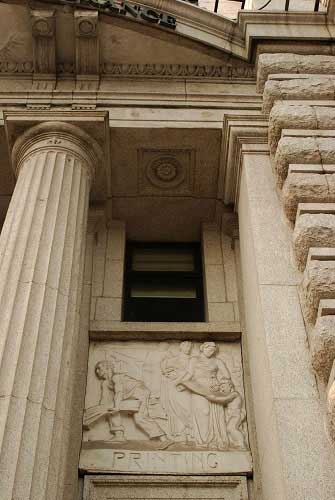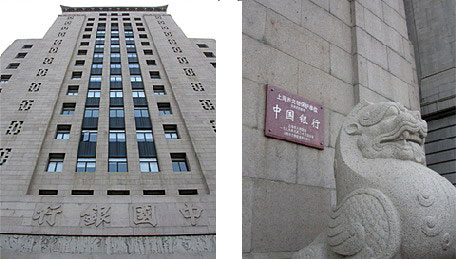
The Bank of China Building is a tower located at No. 23 on the Bund, in Shanghai, People's Republic of China.
It was built on the site of the old German Club (c. 1937). It housed the headquarters of the Bank of China. The stunted appearance of the building is attributed to Victor Sassoon's insistence that no other building on the Bund could rise higher than his.
The Bank of China purchased land in Renji Road and Yuanmingyuan Road in 1930. From then on, the Shanghai branch would each year set aside RMB 500,000 from its surplus, as the construction fund. In April 1934, the board of directors decided to construct an 18-floor building, for the office administration and operation of the Head Office and the Shanghai Branch. The estimated basic construction cost was RMB 6 million.
Why did the bank officials want to have a building in the Bund concession? According to Zhang Jia and Wang Ao, the then presidents of the Bank of China, it was because "Bank of China had endured hardship and thrived. Since its infrastructure had been reformed and it was strong enough to compete with those European and American banks on the Bund, it needed a new building, which could symbolize modernity, soundness and international credit."
In the original design, this building had 34 floors and would be the highest in the Far East. Actually,, the current foundation was still strong enough for a 34-floor building. However, Victor Sassoon insisted that "any house built next to my building is not allowed to be higher than the spire of the Sassoon House". The Municipal Council of the British concession refused to issue the construction permit with an excuse of "Chinese were poor in designing ability and the 34-story building would do harm to the foundations of the surrounding buildings". Finally, the Bank of China building was cut nearly half, with a top height 1 foot lower than the nearby Sassoon House.
In September 1934, Bank of China established a special Management Council to deal with the construction of the building, chaired by Mr. Bei Zhuyi, Head Office's Overseas Department manager and Shanghai Branch manager. The design drafts were jointly prepared by a famous Shanghai design firm Palmer and Turner and Mr. Lu Qianshou, the Chief Architect of the Bank of China. Dao Kee Construction Co., Ltd, a local firm, won the bid by proposing a budget of RMB 1.813 million for the 18-month project.

In 1935, the government of the Republic of China started restructuring the Central Bank, Bank of China and Bank of Communications. Bank of China, whose stocks were 80% publicly owned, became the target of plunder by various powers. It was forced to add RMB 15 million government stocks, making its total capital RMB 40 million, half public and half government owned. With this, the control fell into the hands of the government and Song Ziwen became chairman of Bank of China.
On October 10, 1936, Song Ziwen presided over the foundation-laying ceremony of the Bank of China Tower at No. 23 on the Bund. The building was topped out in 1937. Right then, the War of Resistance against Japan broke out, which postponed the completion. In 1941, it served as the office of the reserve bank of Wang Jingwei's illegitimate government; it had been turned over to the Central Bank after the victory against the Japanese. After several rounds of negotiations, Bank of China didn't move to that building till the New Year of 1946, ten years from the time it was built.
The Bank of China Tower occupies a gross floor area of 50,000 m2, consisting of two buildings. The east building is the main one. It is 15 floors facing the Bund. The ground floor has a higher ceiling, plus two floors underground, making a total of 17 floors. The west building is the annex in four floors. The overall outlook carries a traditional Chinese style, clad in smooth Jinshan stones. Its top is a pyramid with a square base. Parts of the brackets are decorated with stone door arches. A cut-out of the Chinese character for "longevity" can be spotted on both sides of each floor, imparting a calm and peaceful air to the grand construction. Traditional decorations are also adopted for the flower patterns and panes on the railing.